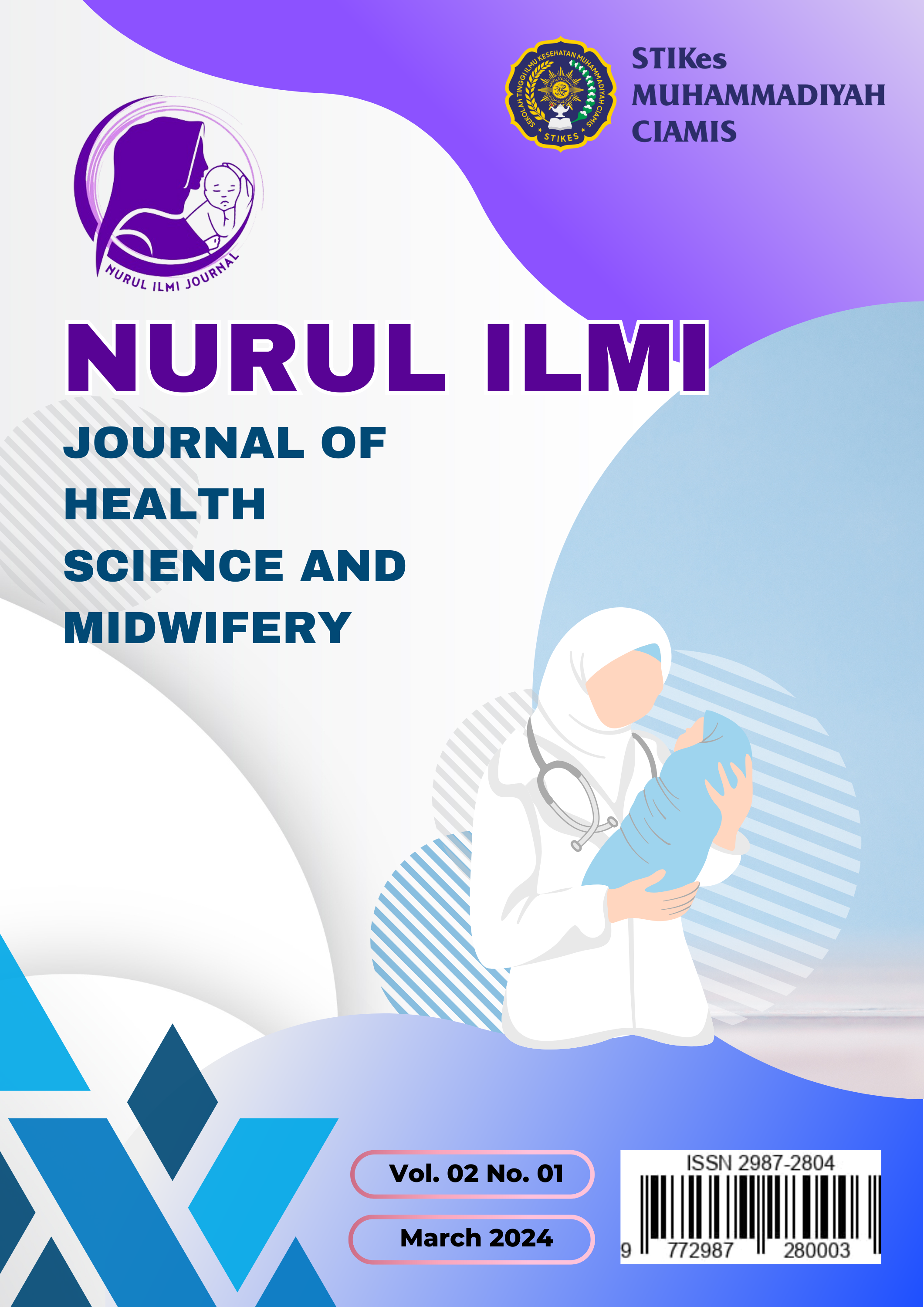Knowing About Anemia Does Not Guarantee That Young Women Are Not Anemic
DOI:
https://doi.org/10.52221/nuri.v2i1.541Keywords:
anemia, knowledge, young womenAbstract
Introduction: Anemia in adolescents will have an impact on decreased focus on learning, decreased physical fitness, impaired growth and development. Knowledge is the basis for someone to apply behavior. Objective: To determine the relationship between adolescent girls' knowledge about anemia and the incidence of anemia in Glodogan Village, Klaten Selatan, Klaten. Method: this is a cross sectional research. Carried out from July to December 2023. The sampling technique uses accidental sampling, about 39 samples were obtained. Hb measurements are then interpreted with the incidence of anemia in adolescent girls. Data analysis uses univariate and bivariate data analysis. Result: The majority of respondents (76.9%) are middle adolescents, about 13-17 years. The majority of respondents' education level is secondary education (56.4%). Upper arm circumference some respondents were abnormal (56.4%). Body Mass Index most of the respondents were normal (76.9%). Almost half of the respondents suffer from anemia (43.6%). More than half of the respondents had good knowledge (61.6%). Based on the test of two variables, it was found that there was no relationship between knowledge about anemia and the incidence of anemia, where as many as 23.1% of teenagers who had good knowledge suffered from anemia. Conclusion: There was no relationship between knowledge about anemia and the incidence of anemia. For further researcher, it is hoped to explore other factors that influence the incidence of anemia. Community health center is expected increasing community empowerment in preventing anemia.
References
Basith, A., Agustina, R., & Diani, N. (2017). Faktor-Faktor Yang Berhubungan Dengan Kejadian Anemia Pada Remaja Putri. Dunia Keperawatan: Jurnal Keperawatan Dan Kesehatan, 5(1), 1–10. https://jdk.ulm.ac.id/index.php/jdk/article/view/443
Budiarti, A., Anik, S., Putu, N., Wirani, G., Tinggi, S., Kesehatan, I., & Surabaya, H. T. (2021). Studi Fenomenologi Penyebab Anemia Pada Remaja Di Surabaya. Jurnal Kesehatan Mesencephalon, 6(2). https://www.ejournal.stikeskepanjen-pemkabmalang.ac.id/index.php/mesencephalon/article/view/246
Cook, R. L., O, N. J., Parker, H. M., Donges, C. E., Lun Cheng, H., Steinbeck, K. S., Cox, E. P., Franklin, J. L., Garg, M. L., Rooney, K. B., & O, H. T. (2017). Iron Deficiency Anemia, Not Iron Deficiency, Is Associated with Reduced Attention in Healthy Young Women. Nutrients, 9. https://doi.org/10.3390/nu9111216
Fernandez-Jimenez, M. C., Moreno, G., Wright, I., Shih, P.-C., Vaquero, M. P., & Remacha, A. F. (2020). Iron Deficiency in Menstruating Adult Women: Much More than Anemia. Https://Home.Liebertpub.Com/Whr, 1(1), 26–35. https://doi.org/10.1089/WHR.2019.0011
Indrawatiningsih. Faktor-Faktor yang Mempengaruhi Terjadinya Anemia pada Remaja Putri Jurnal Ilmiah Universitas Batanghari Jambi. (n.d.). Retrieved March 30, 2024, from http://ji.unbari.ac.id/index.php/ilmiah/article/view/1116
Kementerian Kesehatan RI. (2018a). Pentingnya Konsumsi Tablet Fe Bagi Ibu Hamil. Jakarta.
Kementerian Kesehatan RI. (2018b). Profil Kesehatan Indonesia Tahun 2018. (Jakarta:Balitbangkes)
Kemenkes (2024). Mengenal Dampak Anemia Pada Remaja. (n.d.). Retrieved March 24, 2024, from https://upk.kemkes.go.id/new/mengenal-dampak-anemia-pada-remaja
Martini, M. (2015). Faktor - Faktor Yang Berhubungan Dengan Kejadian Anemia Pada Remaja Putri Di Man 1 Metro. Jurnal Kesehatan Metro Sai Wawai, 8(1), 1–7. https://doi.org/10.26630/JKM.V8I1.162
Masthalina, H., Laraeni, Y., Putri, Y.(2015). Pola Konsumsi (Faktor Inhibitor Dan Enhancer Fe) Terhadap Status Anemia Remaja Putri. Jurnal Kesehatan Masyarakat, 11(1), 80–86. https://doi.org/10.15294/kemas.v11i1.3516
Mularsih, S., Kebidanan, A., & Semarang, A. H. (2017). Hubungan Pengetahuan Remaja Putri Tentang Anemia Dengan Perilaku Pencegahan Anemia Pada Saat Menstruasi Di Smk Nusa Bhakti Kota Semarang. Jurnal Kebidanan, 6(2), 80–85. https://doi.org/10.26714/jk.6.2.2017.80-85
Munro, M. G. (2023). Heavy menstrual bleeding, iron deficiency, and iron deficiency anemia: Framing the issue. International Journal of Gynecology & Obstetrics, 162(S2), 7–13. https://doi.org/10.1002/IJGO.14943
Mustika Dewi, I., Putri basuki, P., Candra Marlina STIKES Wira Husada Yogyakarta, R., Babarsari, J., & Bayan, T. (2020). Hubungan Tingkat Pengetahuan Tentang Anemia Dengan Kejadian Anemia Pada Remaja Putri.
Nainggolan, O., Hapsari, D., Titaley, C. R., Indrawati, L., Dharmayanti, I., & Kristanto, A. Y. (2022). The Relationship Of Body Mass Index And Mid-Upper Arm Circumference With Anemia In Non-Pregnant Women Aged 19–49 Years In Indonesia: Analysis Of 2018 Basic Health Research Data. PLOS ONE, 17(3), e0264685. https://doi.org/10.1371/JOURNAL.PONE.0264685
WHO. (2018). Global Health Observatory (GHO) data.
Downloads
Published
How to Cite
Issue
Section
License
Copyright (c) 2024 Rahmi Nurrasyidah, Kuswati Kuswati

This work is licensed under a Creative Commons Attribution 4.0 International License.













